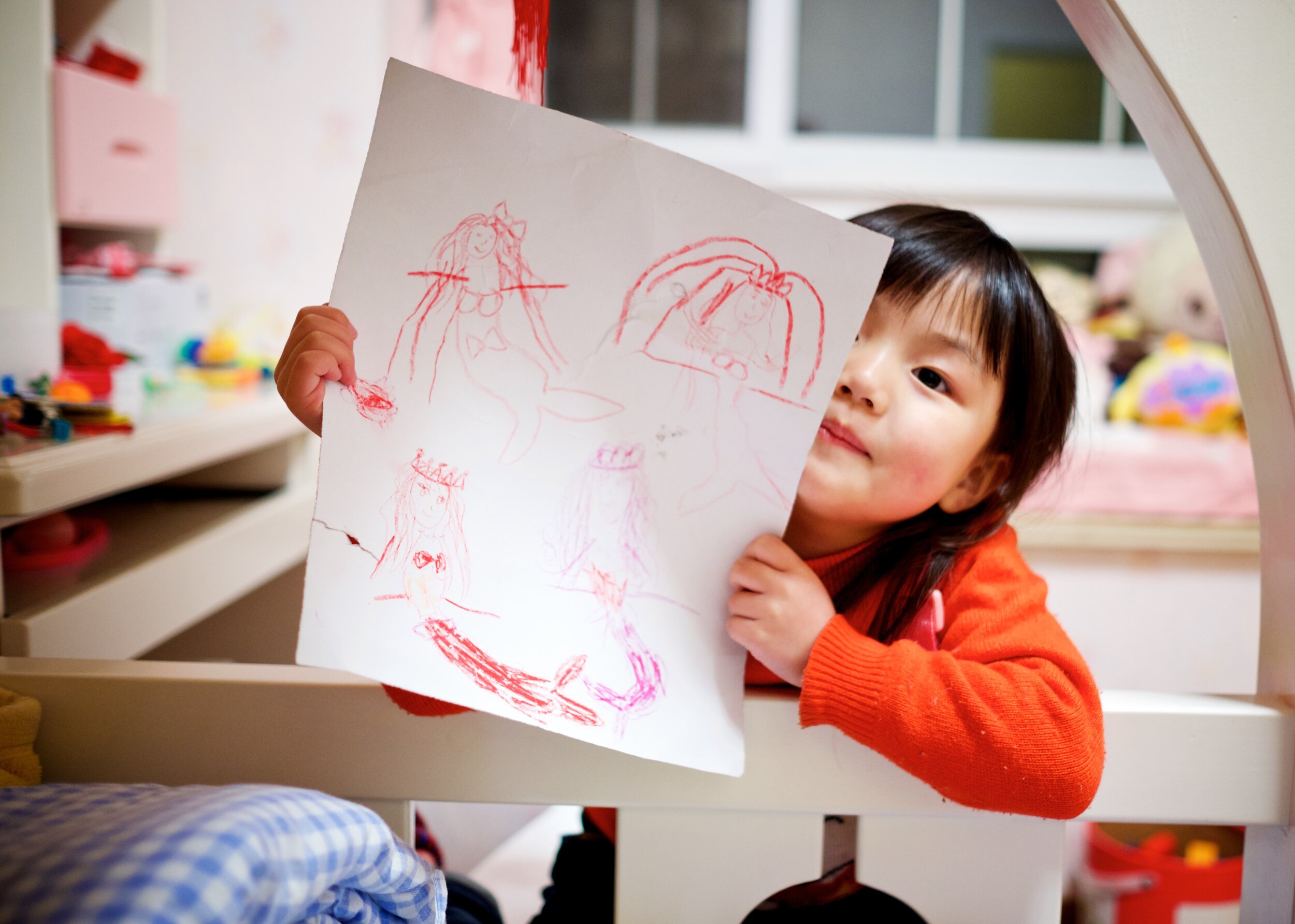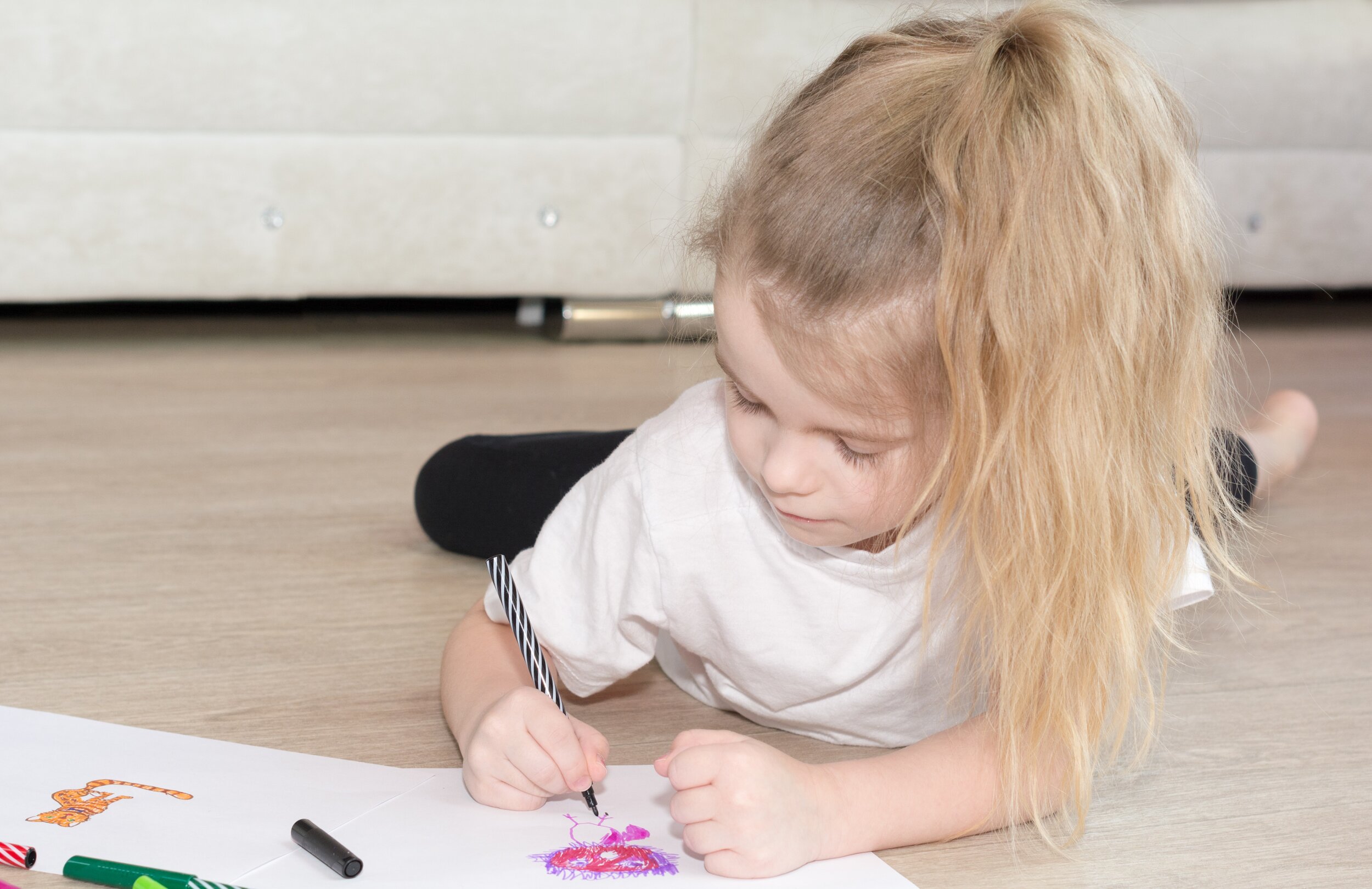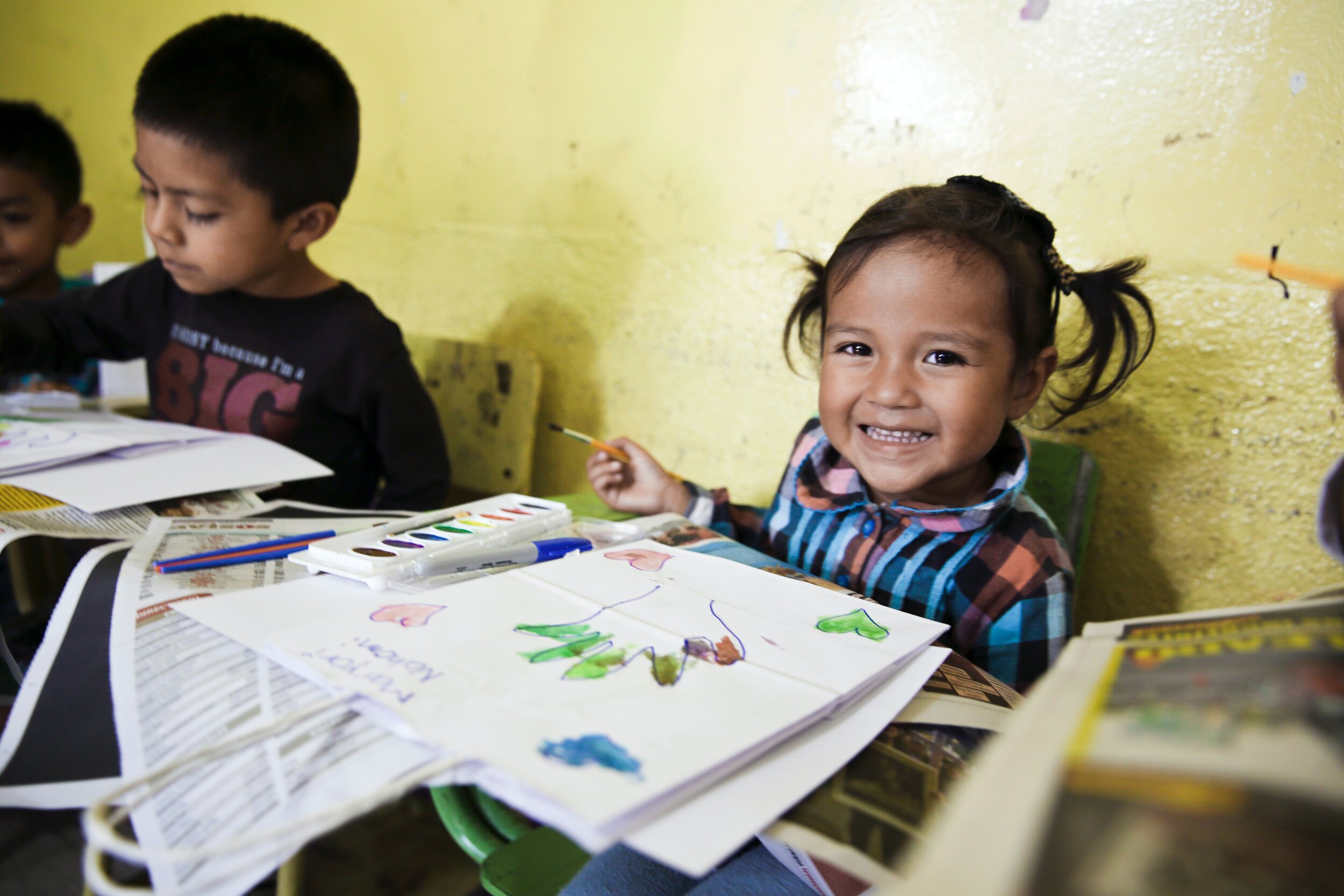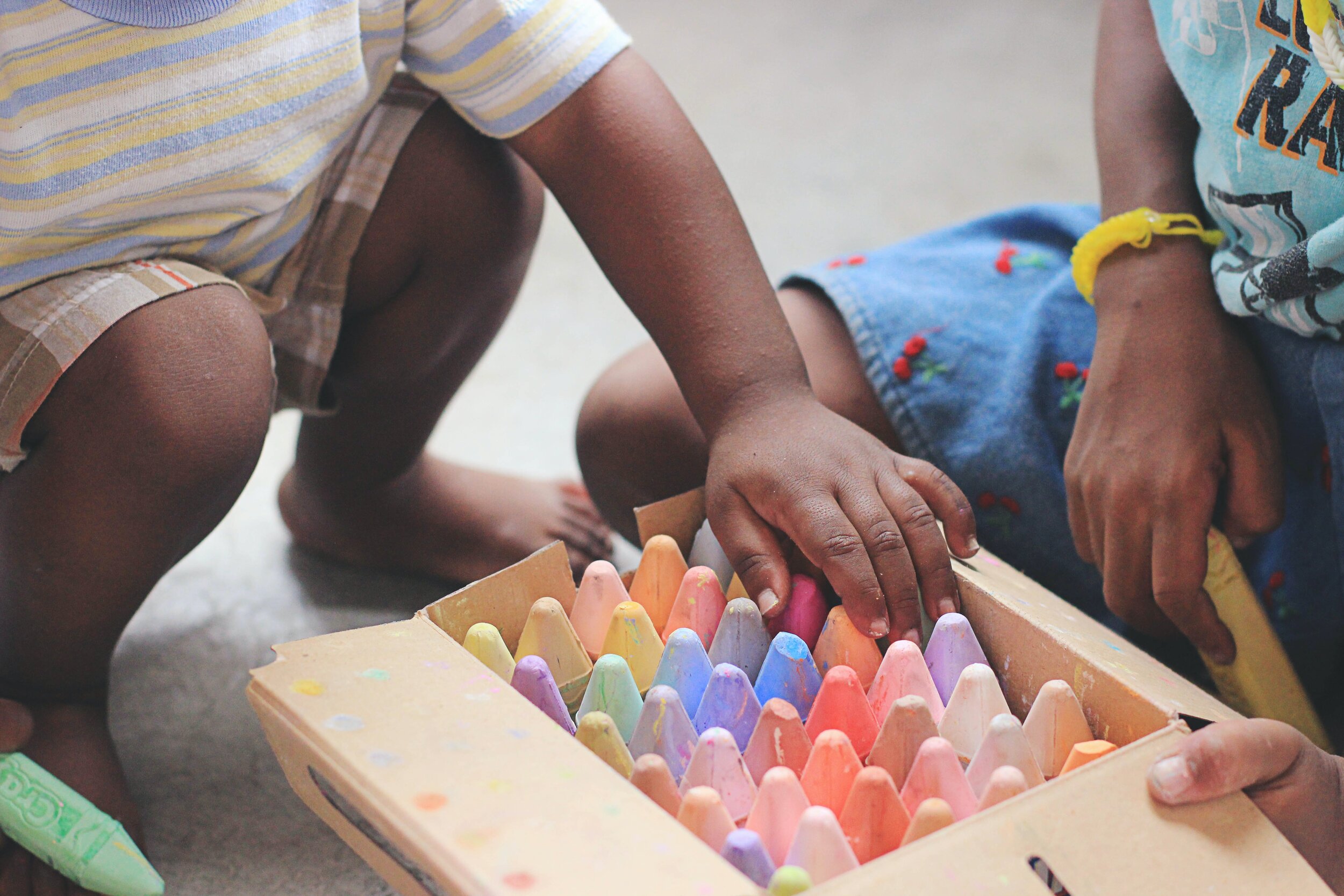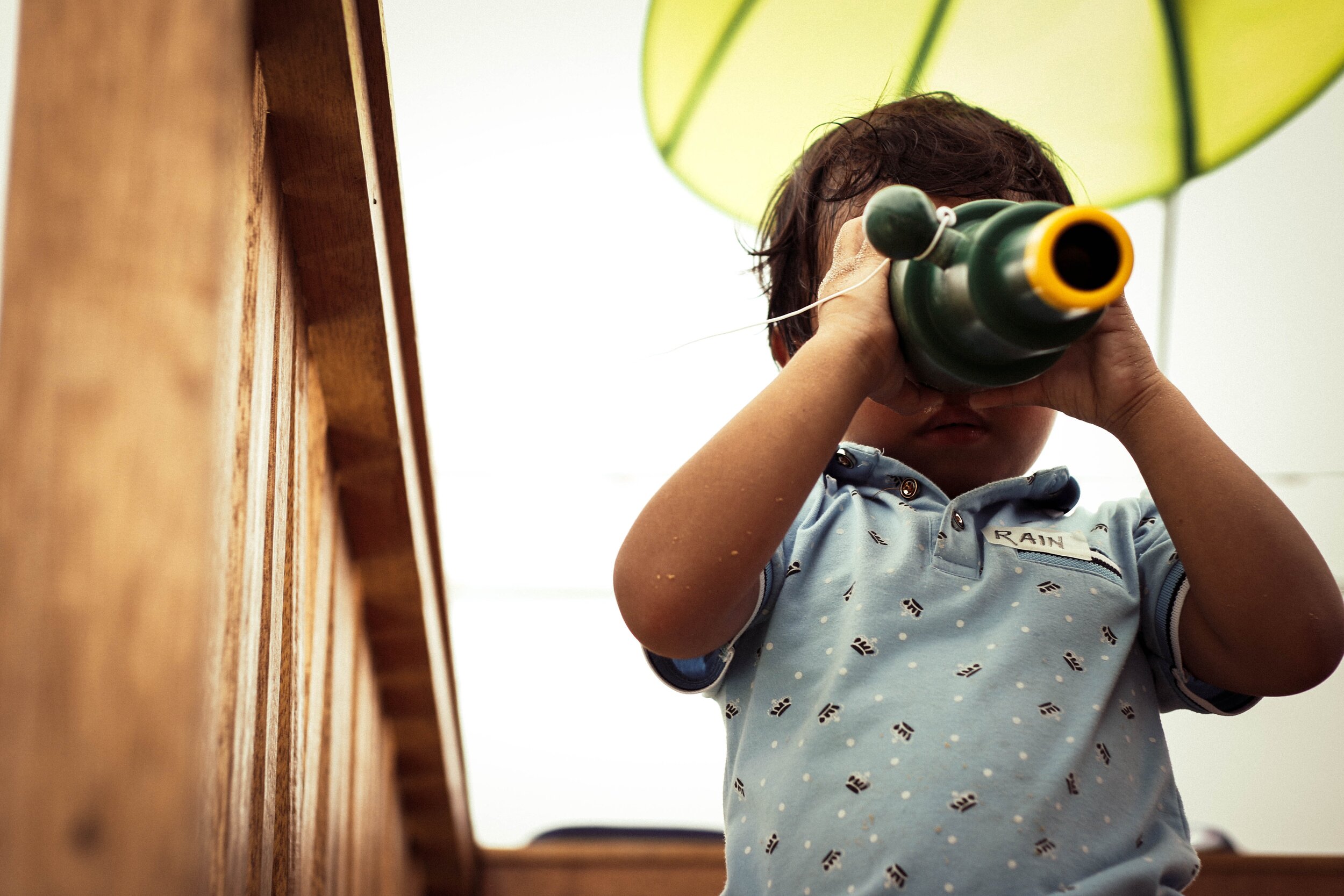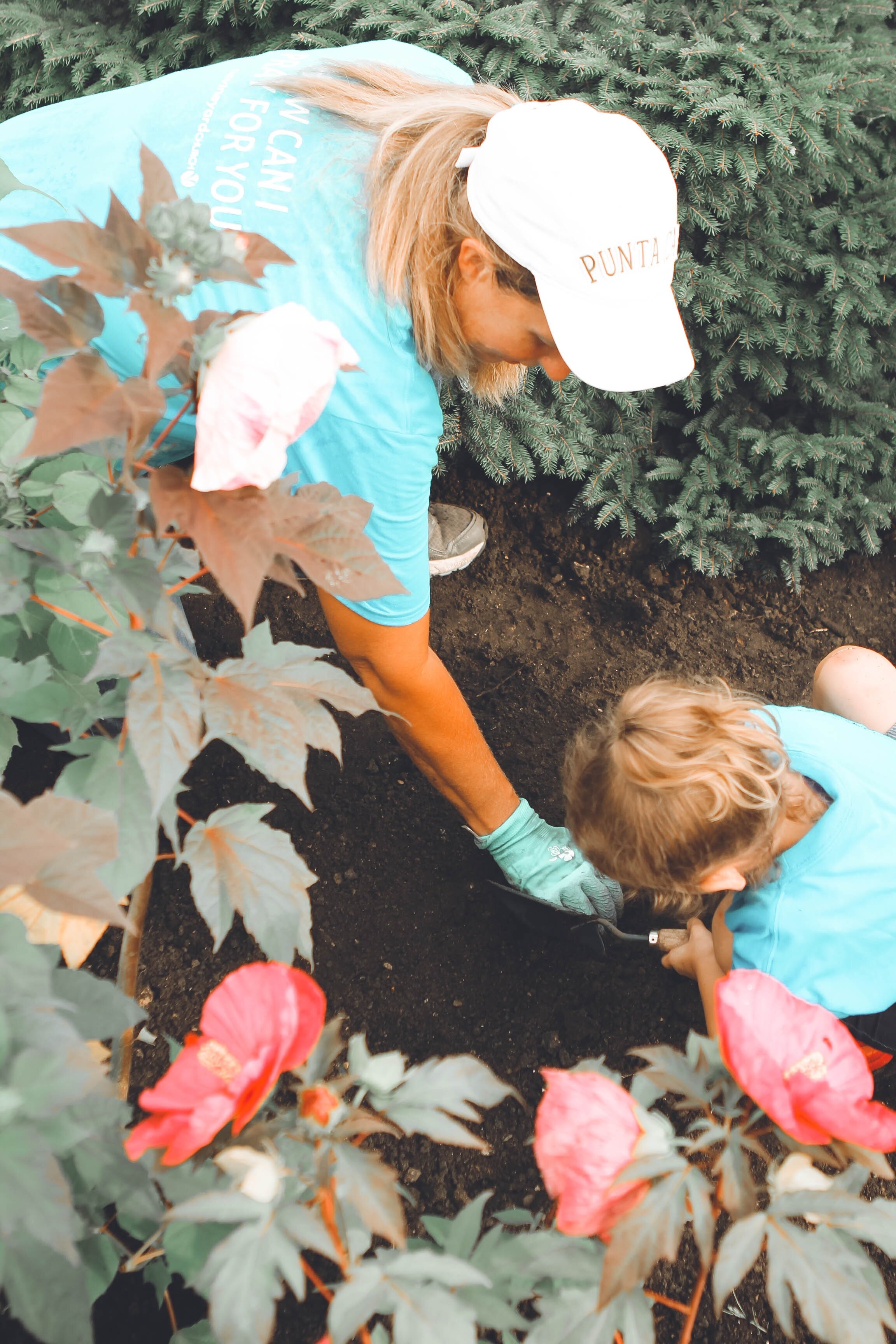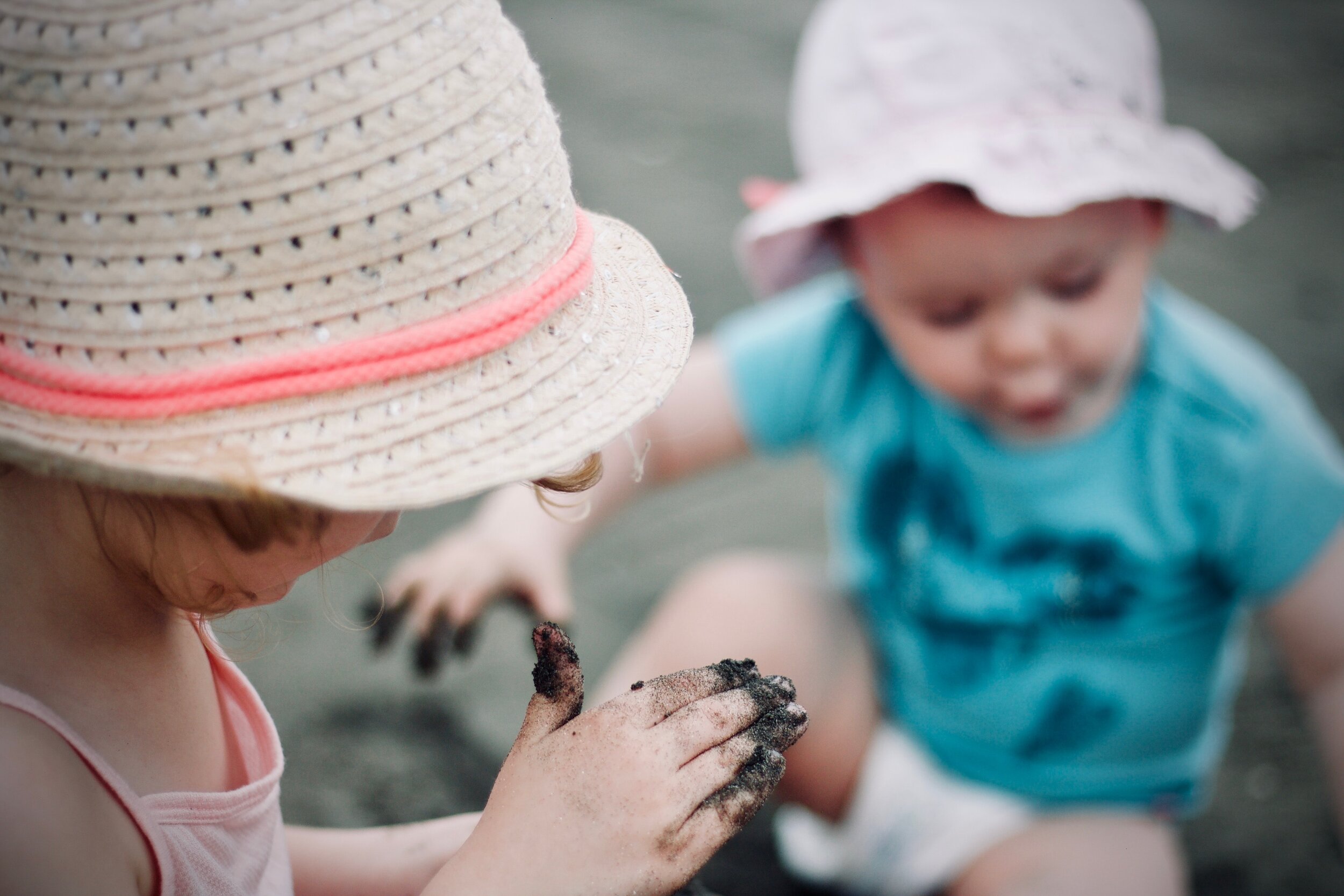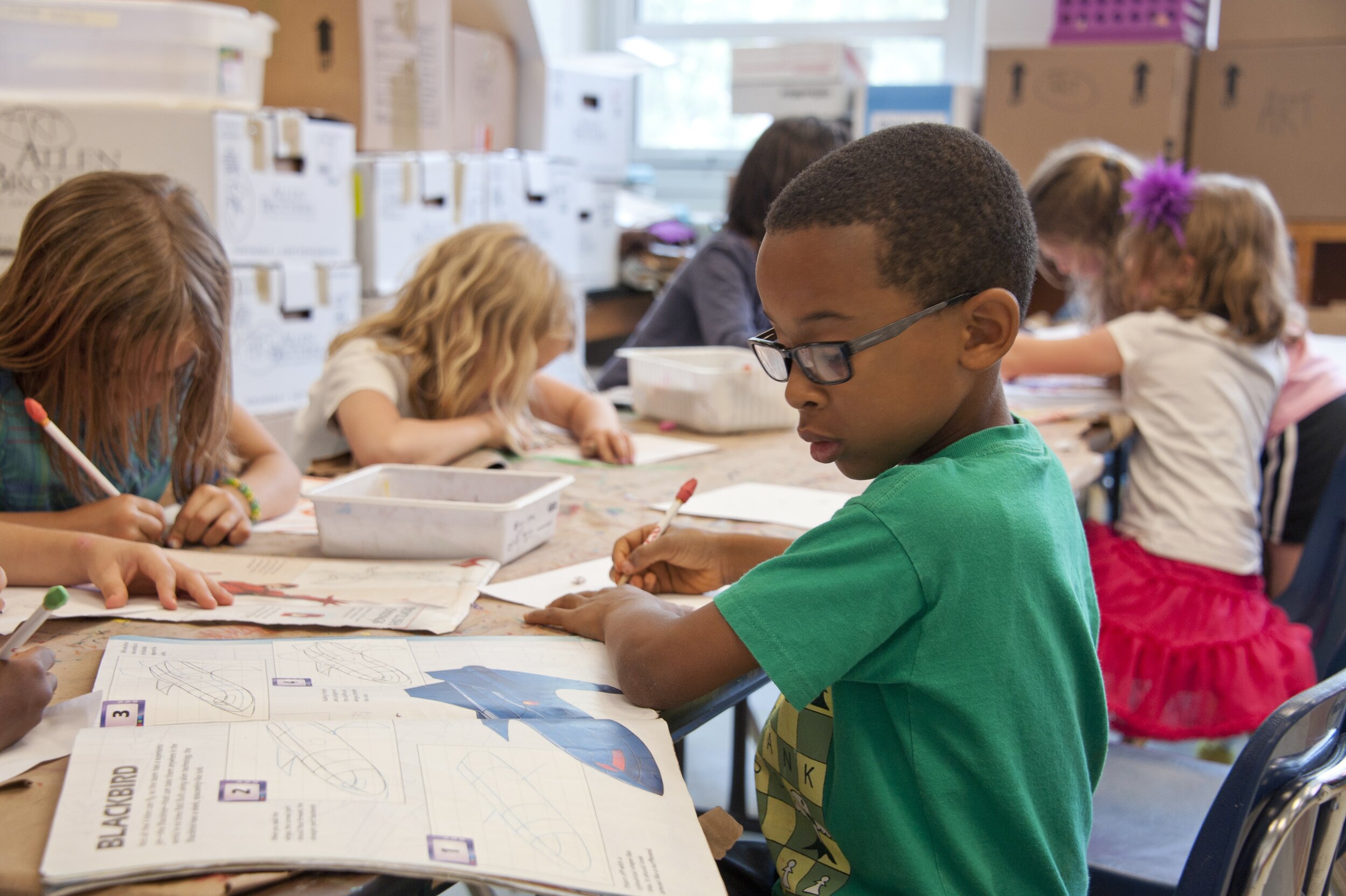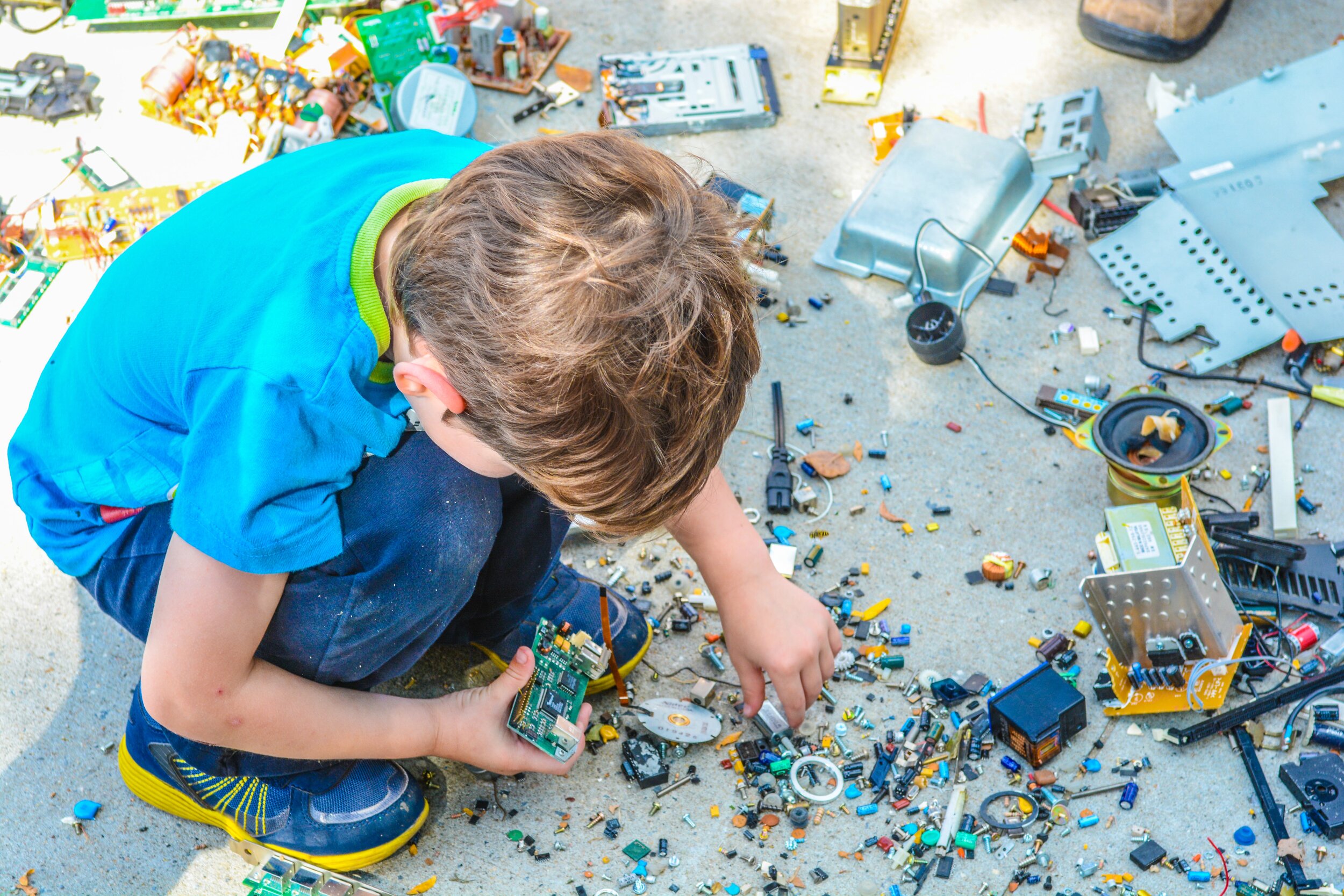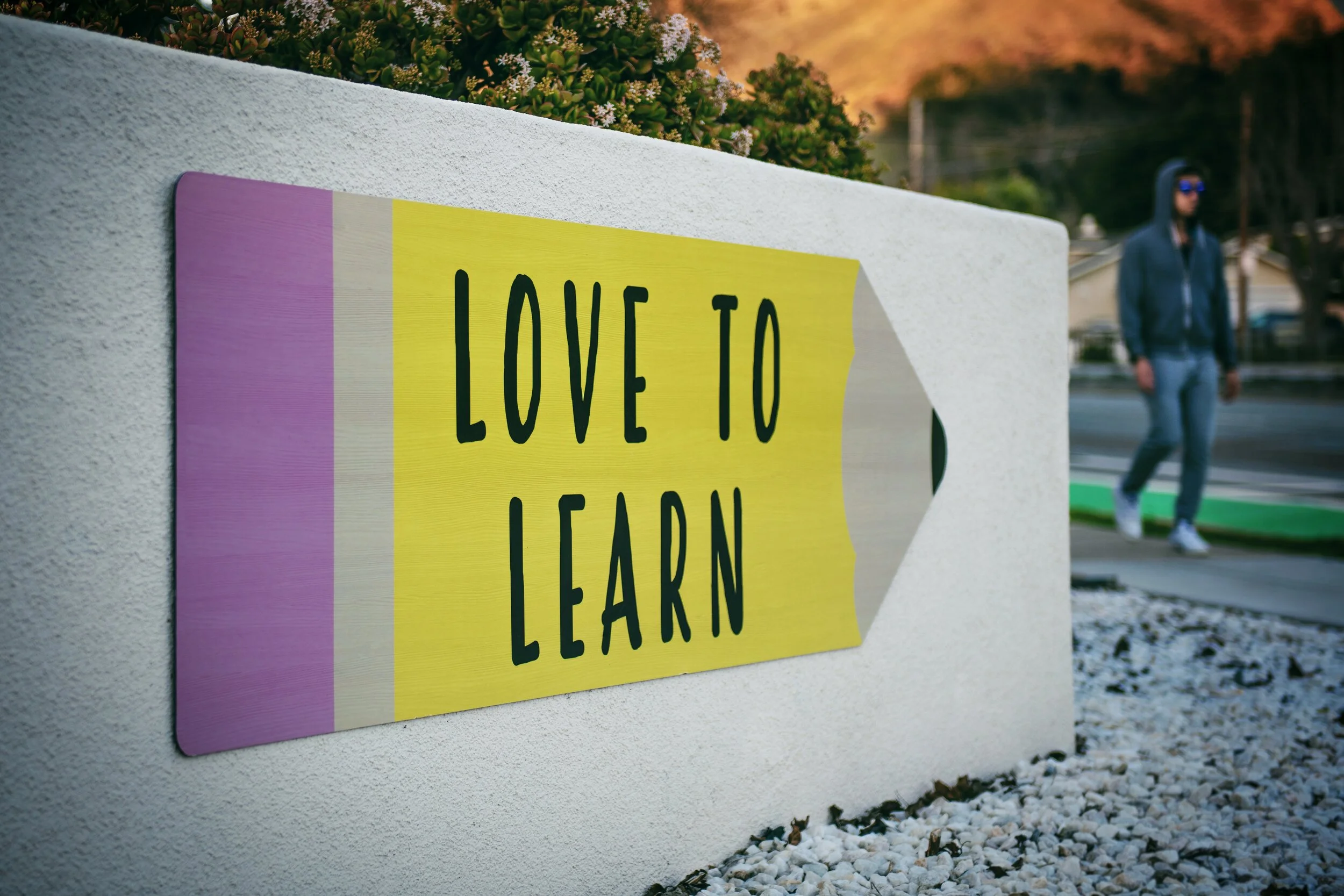What is Possible?
Reggio-inspired professional development in a diverse urban public school: cases of what is possible
by Susan Lyon and David M. Donahue
Reggio-inspired professional development for teachers and instruction for children is possible in racially, linguistically, and economically diverse urban public schools lacking the financial resources available at other preschools typically using Reggio programs in the United States. These case studies of two teachers illustrate what is possible when teachers learn about documentation as a process of making meaning with children rather than a product to prove effective instruction. Teachers expand their ability to observe, listen, and collaborate with each other, parents, and children. They see themselves as researchers, children as capable, and the environment as a third teacher.
Policy makers and researchers recognize children’s first five years as crucial to their intellectual and social development (First Five California 2007; Gopnik, Meltzoff, and Kuhl 1999; United States Department of Education 2005). In the United States, this recognition is leading to interest in expanding access to high-quality early childhood education and new models of early childhood education incorporating understandings about the social construction of knowledge, the implications of brain research, and developmentally appropriate practice in multicultural societies. Frequently, the search for such models has led to the preschools of Reggio Emilia, Italy (Davilla and Koenig 1998; Gandini, Etheredge, and Hill 2008). Almost two decades ago, Newsweek (1991) identified them as the best in the world and their popularity as model has increased every year. Impressed at ‘how they cultivated imagination and, in the process, how they empowered the children’s sense of what is possible,’ Jerome Bruner (quoted in Gandini, Etheredge, and Hill 2008) described them as ‘better than anything I’d ever seen’.
Reggio’s municipal infant-toddler centers and preschools are mandated by law and provide universal high-quality care for children from birth to age 6. Childcare programs are well funded, teachers are well educated, and professional development is ongoing, student focused, and teacher directed. Teachers document children’s learning, understand documentation as part of the process of teaching and learning rather than a result of it, and use documentation as the basis for working with colleagues, parents, and children to develop meaningful, appropriate curriculum and instruction.
A strong sense of community responsibility for children, a commitment to constructing knowledge with others, and attention to artistic processes and the aesthetic qualities of life and learning characterize the Reggio approach (Gandini, Etheredge, and Hill 2008).
Loris Malaguzzi, the founder of Reggio Emilia’s infant-toddler centers, expressed the philosophy on which the schools are based in his poem The hundred languages of children (1987). Children express themselves in the languages of hands, listening, the body, play, imagination, love, and more - ‘languages’ or ways of understanding and entry points to learning that are the cornerstone of early childhood education in Reggio Emilia, but often under-utilized in US schools focused on narrow definitions of knowing as articulated in standards measured by standardized tests (Seidel 2008; Whitfield 2005).
Currently, despite calls for universal preschool in the USA, programs of Reggio’s quality are rare in diverse, urban public school districts where teachers often lack bachelor’s degrees and funding is minimal. In particular, urban school districts rarely commit themselves to ongoing professional staff development, a crucial factor in high-quality early childhood education, which is a mainstay of Reggio Emilia. Few urban districts have supported teachers to document children’s learning and reflect on the implications for practice (Shonkoff and Phillips 2000). In the USA, university laboratory schools (Kantor and Whaley 1998; Weisman Topol 2005), private preschools (Fyfe, Caldwell, and Phillips 1998; Schwall 2005), and public childcare centers in wealthy school districts (Firlik 1996; Mumbrue 2008; Tarini and White 1998) have taken the lead in implementing early childhood education along the lines of Reggio Emilia and the literature reflects this imbalance. Such differential availability of high-quality preschool contributes to endemic poverty (Cochran 2007; Polakow 2007) and raises questions about equity for subsequent K-12 education (Gilliam and Zigler 2000; Howes et al. 2008; Peisner- Feinberg et al. 2001).
As part of the Innovative Teacher Project, one of the authors, Lyon, brought professional development based on Reggio principles to a public child development center serving a racially, linguistically, and economically diverse population. The three-year pilot project from 2001 to 2004 worked with teachers at the Presidio Child Development Center (PCDC) in the San Francisco Unified School District to develop a conceptual understanding of the Reggio approach to early childhood education and the practical knowledge to implement it in a setting lacking the financial resources available at other preschools typically using Reggio programs.
Because the US context differs from Italy, practitioners and researchers have asked how the Reggio approach to early childhood education can be brought to the USA with its racial, cultural, and linguistic diversity and lack of strong financial support for public early childhood education (Katz 1994; New 1994). By focusing in depth on two teachers at PCDC, this study sought to document and understand in the context of US urban public education:
How, if at all, professional development in the Reggio approach to early childhood education affects teachers’ conceptualization of their work, and
How, if at all, such professional development affects their practice.
Findings from this study illustrate that teachers, including those in diverse urban public schools, can learn about and implement the Reggio practice of documentation.
As a result, they start to see children as highly capable, themselves as researchers, and the environment as a support for children’s learning. Such changes take time, particularly for teachers to shift their notion of documenting student learning as a product - a panel on a wall ‘proving’ the children have been engaged in activities - to a process - one that supports inquiry into children’s ongoing meaning making. This shift was key at Presidio. As the teachers, through their professional development, became aware of the hundred languages of children, they learned how to use children’s hundred languages to shape their classroom curriculum and teaching. The cases described in this article demonstrate that what is considered the best in high-quality early childhood education is possible in urban public school districts.
The schools of Reggio Emilia
The Municipal Infant Toddler Centers and Preschools of Reggio Emilia, Italy began in 1963 with the opening of the first preschools for children ages three to six, followed in 1971 by the infant and toddler centers for children from three months to three years old. Reggio educators refuse to use the term ‘model’ when talking about their approach and instead describe their schools as a comprehensive education project for children from birth to six years old. According to Reggio educators, ‘the aim of this project is to promote children’s education through the development of all their languages: expressive, communicative, symbolic, cognitive, ethical, metaphorical, logical, imaginative, and relational’ (Infant-Toddler Centers 1999).
Based on continuous research and analysis of actual practice, Reggio educators formulate new theoretical interpretations, hypotheses, and ideas about learning and teaching. The cornerstone of the Reggio philosophy is an image of the child as competent, strong, inventive, and full of potential – a subject with rights instead of needs. Reggio educators’ respect towards children and adults is evident in the following aspects of their educational philosophy: participation of children in developing curriculum, ongoing permanent staff development, collegiality among teachers, the importance of the school environment in shaping children’s learning, the atelier or workshop where children explore ideas and make their thinking visible, and constructivism as the conceptual framework informing children’s learning (Gandini 2008).
Drawing on constructivist learning theory, Reggio educators see children as protagonists, or active constructors of their own knowledge. Forman (1995) explains that it is through a process of rereading, reflection, and revisiting that children are able to organize what they have learned from a single experience within a broader system of relations. These processes are individually and socially constructed drawing on children’s one hundred languages or ways of knowing (Malaguzzi 1987). Likewise, the teacher is a protagonist who engages in the same processes with colleagues, making individual and collective interpretations about children’s learning and the development of curriculum. Social constructivism informs the teachers’ respect for the children’s need to generate their own questions and revisit their ideas. According to Forman (1995), this metacognitive perspective practiced in the Reggio schools facilitates constructing schema of implication among facts rather than memorizing discrete, unconnected facts. The teacher helps children make sense of, not just remember, experience. The children are taught to infer, predict, and confirm. The Reggio approach connects knowledge construction to reciprocal communication. Education is based on communication within teacher-teacher, child-child, teacher-child, parent-child, parent-teacher, and parent-parent relationships. Educators see the school as a place of participation and research lending to shared construction of meaning.
The literature on documentation and teacher as researcher
One of the key features of Reggio Emilia’s early childhood program is documentation to promote and understand children’s learning and the role of teacher as researcher (Gandini, Etheredge, and Hill 2008; Katz 1998). Understanding documentation and teaching as research was the most significant learning for the teachers profiled in this article. The literature in this section describes what these terms mean in Reggio and the United States.
Forman and Fyfe (1998) define documentation as ‘any activity that renders a performance record with sufficient detail to help others understand the behavior recorded’. Documentation is intentional. Teachers think about what and why they are documenting beforehand (Gandini 2005). Reggio teachers document children’s thoughts and actions. They take copious notes, recordings, and photographs to capture children’s thinking and make the learning of teachers and children visible, often through panels displaying these artifacts and the teachers’ and children’s interpretations of what is happening in the process (Edwards 1998; Tarini 2008; White 2008).
Documentation is part of the daily life of the schools in Reggio Emilia. Educators emphasize documentation as integral to fostering learning and shaping the learning-teaching relationship (Katz 1998; Rinaldi 2001). Documentation is also about the ongoing search for meaning - that is, finding, or rather constructing, the meaning of school as a place for children’s and teachers’ learning. As Forman and Fyfe (1998) state, ‘the intent of documentation is to explain, not merely to display. According to Katz and Chard (1996), documentation in US education has referred to collecting documents for a different purpose: to demonstrate the truth of a fact, to confirm a scientific thesis, or to conceptualize knowledge as an objective and demonstrable entity. For example, analyzing a portfolio or giving it to parents and children after instruction to show the work that has been completed is very different from documentation in Reggio, where teachers and children use those same materials to gain a greater understanding during the learning process (Forman and Fyfe 1998; Lewin-Benham 2006).
Portfolios and other forms of documentation (video, audio-recordings, written notes, daily journals) are described in Reggio as visible learning (Rinaldi 2001), visibility that testifies to the children’s learning processes and which are possible precisely because they are visible. This ‘making visible’ allows for relationships that the building blocks of knowledge. It opens up the possibility of discussion, comparison, and asking questions among adults and children during the experience. Dialogues between children and children, adults and children, and adults and adults are part of the documentation process (Forman and Fyfe 1998). Dialogue is sparked because children’s work, especially their art, is seen as ‘graphic language’ and taken seriously as the basis for curriculum planning rather than only classroom decoration (Katz 1998). Documentation, a form of classroom memory’ (Edwards 1998), is revisited many times by both children and adults to gain an awareness of their learning and thus promote further learning (Katz 1998; Rinaldi 1998).
Just as the Reggio approach to documentation departs from notions of assessment and ‘proof,’ the Reggio approach to teacher as researcher departs from notions of positivist educational research conducted by outsiders studying classrooms. Instead, Reggio teachers’ inquiry is complementary to a tradition of ‘“insider” research done by practitioners ... using their own site ... as the focus of their study’ (Anderson, Herr, and Nihlen 1994). Often called ‘action research,’ such teacher research refers to systematic and deliberate reflection of data, often in conjunction with colleagues, to answer questions with implications for improving practice (Kalnin, Freedman, and Simmons 1999; Mills 2003).
While the Reggio approach to teachers as researchers focuses on insiders examining classroom life, it stands in contrast to conceptions of action research that emphasize more formal ‘spirals’ (Kemmis and McTaggart 1988; Stringer 1996), ‘cycles’ (Calhoun 1994; Wells 1994), or ‘steps’ (Creswell 2002; Sagor 2000) of research, starting with a plan of action, implementation of the plan, observation of its effects, and reflection on its success to determine future actions. Rather than testing the effectiveness of curriculum and instruction, Reggio documentation is embedded in curriculum and instruction (Rinaldi 2001) and is part of how teachers and children make meaning and become metacognitive about their meaning making (Edwards 1998).
Documentation is part of the process of progettazione, the word used in Reggio to convey a complex web of hypotheses, observations, predictions, interpretations, planning, and exploration. In the Reggio approach, the process of documentation is as important as the product of documentation. Cadwell (1997) explains that documentation is considered a form of communication in the schools. There is a sense of a story which weaves together the actions of adults and children. Teachers’ commentary on the purposes of their study and the children’s learning process, transcriptions of children’s verbal language, photographs of their activity, and representations of their thinking in many media are composed in carefully designed panels or books to present the process of learning. This documentation is a purposeful process for children, parents, and teachers. The documentation created by teachers shows children that their work is valued. Parents are able to read the documentation in the school and become aware of their children’s experiences. The teachers’ use of documentation allows them to better understand children, evaluate their own work, and exchange their ideas with colleagues and other educators (Gandini, Etheredge, and Hill 2008).
Methods
Presidio Child Development Center is one of 37 child development centers in San Francisco serving infants through school-age children. Of the Center’s 223 children at the time of the study, 48% were Asian, 19% white, 16% Hispanic, and 14% African American. Many students are from low socio-economic backgrounds. With funding from the Innovative Teacher Project (ITP), PCDC implemented a three-year pilot project (2001-2004) to introduce the staff to the documentation practices of Reggio Emilia.
The Innovative Teacher Project began in 1994 as a professional development project inspired by ‘The Hundred Languages of Children’ exhibit from Reggio Emilia, Italy. The project offers professional development through roundtables (where teachers discuss work-in-progress), seminars, and special conferences (Lyon 2008). Since ITP’s founding, practitioners and scholars from Italy as well as the United States have shared ideas and practices with educators from over 20 local schools, including Presidio.
Because they capture the particularities of a phenomenon that is not well understood, case studies are an especially appropriate way to understand teachers’ thinking and learning as they participate in professional development about Reggio Emilia (Merriam 1988; Stake 1994; Yin 1994). The data contributing to the description of professional development at the school were from all three years of the project. The data for the case studies of teachers that follow were collected during the last year of the project. The teachers were selected because they had worked with the pilot project since its inception.
Each teacher was interviewed three times. The first interview elicited information about the teachers’ background, familiarity with the Reggio approach, and their ideas about documenting, listening, observing, and collaborating. The second interview, modeled on Edwards, Gandini, and Nimmo’s ‘video-reflective interview’ (1994), asked teachers to reflect on a 60-minute video recording of their work with children in the classroom. Teachers were asked to comment on what they noticed about the children’s and their own actions and learning as well as connections they saw to practices and ideas from Reggio Emilia. In the final interview, teachers reflected retrospectively on their experiences and new understanding over the course of the three-year project.
Both teachers were regularly observed over the three years of the project; once a week in their team meetings and informally in the classroom. Two observations from the final year were used to document whether and how teachers employed Reggio-inspired practice at the end of the project. The first observation looked for specific evidence of Reggio practice in the classroom (e.g. teacher taking notes, teacher framing questions for children based on her observations). The second observation focused the classroom environment and its use as a ‘third teacher’ (Gandini 1998). Teacher’s journals, notebooks, classroom documentation and minutes of meetings were also used to triangulate data from the interviews and observations and provide context for professional development at Presidio. Interviews and observations were conducted by Lyon, who was also responsible for delivering the professional development at Presidio. Because qualitative researchers are concerned about the effect their own subjectivity may have on data collection and interpretation (LeCompte 1987), this report contains extensive use of participants’ own words so readers may judge the analysis against the data.
Data were first coded according to categories of the documentation process: listening, observing, and collaborating. These categories highlighted connections teachers made between Reggio practices, professional development, their work, and what they saw as significant for their daily interactions with children and families. The data were also analyzed inductively through a process of ‘segmenting’ information (Tesch 1990) and developing coding categories through close readings of the data (Bogdan and Biklen 1998). This process yielded themes such as redefining children’s capabilities as learners, recasting teachers’ roles as researchers, and drawing on the environment for children’s learning.
Like all qualitative research, this study is not meant to be generalized to all teachers or settings. To the extent that some child development centers may share important characteristics with Presidio, some findings might be transferable. The utility of this study, however, is to understand more deeply the particularities of Reggio professional development at one site and reflect more thoughtfully on the possibilities of such work at other similar urban public early childhood education settings.
Findings
In the following section, we present an overview of professional development at the Presidio Child Development Center and two cases of teachers, Sherri and Andra, who work at Presidio. Sherri works in the morning and afternoon program and teams with Andra who works only in the afternoon. The overview of professional development is not meant to be an exhaustive study of change in the school as a whole. That is beyond the scope of this article. Instead it is intended to provide background on the larger context of Sherri’s and Andra’s development. Each case describes how their thinking and practice of documentation changed as a result of Reggio-inspired professional development. In each case, the teachers shifted from a product-oriented understanding of documentation to a process-oriented one. This shift was accompanied by changes in how they observed and listened to children and collaborated with parents and other teachers. These shifts took time and the teachers’ learning is ongoing. These cases present teachers after three years of Reggio-inspired professional development. Cases of their first year would not show such deep understanding of Reggio principles and practice. While cases from the third year of professional development do not show the mistakes, misunderstandings, and the years-long struggles to incorporate Reggio principles, they do show what is possible given a commitment of time in the kind of schools where Reggio practices are rarely considered.
Professional development at Presidio Child Development Center
Consultants from Italy and the United States worked with the school staff on professional development to spark dialogues among teachers at PCDC. The teachers were asked to develop working collaborative relationships among themselves and meet as teams regularly for two hours a week. They also participated in conferences, visited schools implementing a Reggio approach, and, in years two and three, presented their own work from the daily life of the classroom at roundtables at their school.
During the first year, teachers read about the Reggio approach and began questioning and interpreting the daily life of the classroom. Teachers were given notebooks and cameras to document learning in their classroom. Planning curriculum from observations and listening to children required teachers to organize their work differently. Team meetings were to support this end, to provide a place where teachers could share their thinking, questions, and understanding of their daily work with children and families.
This structure of professional development as an ongoing part of the life of the school was new and, at first, difficult for teachers. Prior to this, teachers from the morning shift rarely spoke to teachers in the afternoon shift about the children or the curriculum. The teachers were overwhelmed in the beginning and asked themselves: Where do we start? Many teachers struggled with discussing their ideas and thoughts with others in team meetings because communicating with each other was a change from previous practice where teachers did not express themselves and think critically about the classroom. Teachers had been used to working in isolation and although the professional development offered them the space and time to change that way of working, teachers did not initially value such space and time. During the first year, many teachers became defensive, silent, resistant to change, or unwilling to participate in the team meetings. Notes from the first year show that several teachers brought children to meetings, which impeded discussion. Teachers came late to meetings and long silences punctuated meetings, especially when teachers had not prepared for the meetings. This caused resentment among teachers who did come prepared and wanted to implement change more quickly.
Over time, teachers such as Andra and Sherri, who valued the team meetings as an important part of the Reggio approach, influenced teachers who at first did not want to leave their classrooms and did not see the value of meetings. By the second year, teachers demonstrated such valuing by bringing children’s work to analyze in meetings with other teachers. Whereas in the first year, only two or three teachers would talk in each meeting, notes from the third year show that each teacher was contributing to the meetings. By the third year of the project, teachers stopped bringing children to the meetings in part because they now saw children as strong, competent, and capable. Over the three years, the focus of the conversation shifted. During the first year, meeting notes record teachers complaining about children, co-workers, and families. By the third year, teachers were more likely to focus conversation on curriculum, planning and the organization of the classroom environment.
Learning to observe, listen, and document was a challenge and very different from the teachers’ prior practice. The question posed in their professional development was: How do we make learning visible and how do we communicate the daily life of the school? The first attempts were in forms of panels that were very product oriented, often showing an isolated activity. The teachers only slowly made visible their daily journals.
Eventually, teachers observed children’s learning experiences and these sometimes became the basis of projects in the classroom. Teachers struggled to communicate and document these experiences as they were occurring. Originally, they thought every project had to be in a panel like ‘show and tell.’ Over time, they moved to seeing children’s and their own learning process as a timeline. This was reflected in the portfolios they created for each child. While teachers continued to offer isolated activities to children, they also increased the opportunities for children to build and connect experiences. While they began to see children as protagonists, they still did many things for children that they could have done themselves. Prior to the Reggio project, teachers only documented test scores of children. By the end of the project, teachers documented children’s evolving collaborative understanding. Whereas teachers kept daily or weekly documentation at the beginning of the project, by the end, they kept daily and weekly journals, developed portfolios for each child, and photographed and audio-recorded classroom life.
Changing the environment was a very concrete way to move towards Reggio practice but teachers did not initially include children and parents in the process. They would put new materials in the classroom and then complain the next day that they were broken. Teachers needed to learn how to talk with the children and parents about the purpose of the materials and how they were going to use them. Teachers similarly struggled with looking critically at their own work to create an environment within the school that was based on collaboration. Teachers continue to work on seeing each other as resources and to ask for help in areas in which they are not strong.
Sherri
Sherri, a 28-year-old African American woman, has worked at Presidio for six years as a special education paraprofessional. The mother of a six-year-old who attended Presidio, she is working to complete her bachelor’s degree. She hopes to enter a teaching credential program and work in an elementary school.
Before the Reggio pilot project, Sherri equated documentation with a final product - a panel on the wall or an object made by the child but directed and controlled by the teacher. Such a definition fit into her past practice of using documentation to ‘prove’ that teachers and children were doing something with their time.
1 think before the project, it was based on what is the end result here?... 1 remember ... we read The Very Hungry Caterpillar [Carle 1994], and the children made cut-out pictures of the hungry caterpillar and I put them on the wall. I thought I am doing good. I have something on the wall. It was all about getting a product on the wall.
Over the three years of the pilot project, Sherri came to understand documentation as a process for inquiry that includes listening to, observing, and collaborating with children, teachers, and parents. ‘Now documentation is more of a process. I am... paying attention to what the children are saying and what they are doing and making note of that.’ She sees documentation as part of what Gandini and Goldhaber (2001) describe as a cycle of inquiry into children’s learning that includes asking questions; observing, recording, and collecting artifacts; interpreting evidence; and building theories, asking new questions, and revising practice. Starting with a journal, Sherri moved from taking notes to including photographs, video, and audio-recordings of children’s conversations as her documentation skills grew more elaborate. Documentation served to foster characteristics of Reggio practice such as listening, observing, and collaborating, which served her ongoing investigations into children’s learning.
Sherri used documentation to extend and deepen her listening skills. Comparing her current practice to that before the pilot project, she says,
Before, I’d listen, but now I listen and some of the times 1 might bring a tape recorder to my group so that I can replay what the children said or I’ll always have a notebook with me so 1 can jot down quickly what the children said.
Listening to children’s voices has changed her practice. For example, when the students made rocket ships, Sherri thought of hanging them in the classroom because leaving them piled on a shelf seemed disrespectful. When she asked the children about this, she heard that they wanted the rockets accessible so they could play with them, and she accommodated this request.
Sherri also used documentation to systematize and record observations of children’s learning. Before the pilot project, Sherri noted that observing children was something she did to assess them after a lesson. Now it is ongoing, daily practice.
“Every day I’m paying attention to what the children are doing and jotting down notes so I can either start a project with them or, if we’ve already started a project, 1 will continue to observe them to see what I can do to keep it going.”
Instead of observing to make summative judgments about children’s progress, Sherri now observes for formative understanding of their learning and reflects on the implications for her teaching.
Through the pilot project’s emphasis on documentation, Sherri came to understand social constructivist ideas about learning (Fosnot 1996; Vygotsky 1978). She believes children are capable of building knowledge from their interests and sees how children direct their own work, generate questions and revisit their choices. She prefers an open process of learning, what Forman and Fyfe (1998) call ‘negotiated learning,’ which is ‘child originated’ and ‘teacher framed’. Sherri says,
Now we start an experience, we talk about it, and we can always revisit it, build on it .... It is like a process, feeling comfortable with coming back to things and revisiting things
and really expanding on the experience rather than just closing it off immediately.
For example, Sherri observed that children would come to school in the morning and build a McDonald’s in the block area. Because she observed and documented their play, she revisited the McDonald’s project regularly, even months later, and observed that children enjoyed the continuity. Discussing how she documents what she observes, she said, ‘It’s a really helpful tool for the teachers to make connections to other experiences, expand on the children’s ideas ... . If you don’t have those daily observations, you can’t go as deep as you want to go with the children.’
Slowing down, revisiting projects, and connecting children’s play to curriculum meant leaving behind the school’s rigid schedule of activities, clean up, and snack time. As Lewin-Benham (2006) states, ‘Americans watch the clock; Reggio educators watch the children. They base planning on what they observe, not on predetermined lessons’. By listening and observing, Sherri found that, with fewer interruptions, children displayed capabilities beyond what she had taken for granted. She saw that children could focus and engage when they were interested in an experience and supported by teachers. Referring again to the McDonald’s project, Sherri said, ‘Before the Reggio pilot project, if it was 9:30 and that was clean up time, we’d say, “OK [clap], clean up the McDonald’s. It’s over and we have to move on to the next thing.’ Realizing that the school’s schedule broke the children’s rhythm of learning, Sherri slowed down and departed from rigid scheduling. Instead of putting away the McDonald’s and moving to snack time, Sherri allowed students to serve the snack from the McDonald’s. She reports:
The other children in the classroom stopped whatever they were doing. They came over, some from the dramatic play area. They said, ‘Oh, 1 want to have some snack.’ ... This play went on for the whole morning time, even in the clean up. It was a process of the whole class being involved, because once everybody started feeling like they finished playing, everyone together as a community cleaned up and we went outside. So that was a major breakthrough ... to just go with the flow ... because they were really engaged.
Sherri saw the children were learning letters like M for McDonald’s, numbers for counting money, and how to cooperate. Observing the children working together for an extended period of time raised new questions for Sherri about their capabilities and buttressed her commitment to documenting and reflecting on what children say and do.
In addition to promoting listening and observing, Sherri’s documentation has fostered collaboration. For example, she developed a weekly ‘classroom journal,’ a panel display in her room that is a ‘tool for adults and children to communicate about current projects and interests.’ Here, documentation is not a stand-alone product but part of a process to promote communication. The classroom journal engages parents with questions such as ‘What are your dreams and goals for your child?’ and ‘When you were young, what was your favorite book?’ Parents’ answers spark conversations among children, teachers, and other parents, which are also included in the documentation. Over time, Sherri reports that documentation in the classroom has encouraged a deeper relationship with parents and facilitated communication that was not present before. She also notes increased attendance at the school’s parent meetings.
Sherri’s documentation supports collaboration among teachers as well. She contributes to a notebook that bridged communication between morning and afternoon staff at the school. Using the notebooks daily, teachers write about interactions with parents, grouping of children, and their experiences during the morning or afternoon. These notebooks are then used in team meeting discussions and for planning the next day. Sherri notes that documentation has furthered staff collaboration. ‘We’ve always had a good team ... and I think we always communicated pretty well, but since the Reggio pilot project, ... the more that we do ... documentation, we need to communicate with each other more.’
Sherri needed time to value documentation and its benefits for listening, observing, and collaborating. At first, she was challenged to remember her notebook every day and to have a camera ready. She is still working to incorporate the tape recorder into her practice. Nonetheless, she says that documentation has helped her leam more about the children and see their potential. When she first saw examples of Reggio practice in Italy, she thought the children were ‘geniuses’ and wondered, ‘Where did these children come from? How are they able to do these wonderful things?’ As Sherri documented her children’s learning, she discovered opportunities and resources in her own school. ‘It is all about appreciating your own surroundings and making the most of that. And that comes from the daily observations. When you really pay attention, it’s like, wow, this is really amazing what this child did.’
Andra
Andra, a 42-year-old Chinese American woman, has worked at Presidio for five years as a teacher in the afternoon program. A native of San Francisco, she earned an associate’s degree in early childhood education and has completed coursework in administration and special education in early childhood education. She has a strong interest in travel and is involved in a folkloric dance group. Andra believes her experience learning from the arts and travel helped her connect to the Reggio approach and its attention to observing and listening.
Like Sherri, before the Reggio pilot project, Andra thought documentation was a final product that a teacher completed in isolation. She admitted that documentation was ‘a big question mark’ at the beginning of the pilot project. When a child drew a picture, she would ask the child to tell her more and she would write the story next to the picture. From that beginning, Andra has come to see that documentation is part of a process of inquiry that requires listening, observing, and collaborating on a daily basis. Again, like Sherri, she felt documentation had to ‘prove’ something. Now she says:
After the pilot project, my teaching became more purposeful. I can take my time. The children are going to take their time .... When it is time to put something up, we will put something up and it might be an ongoing thing. It is not an A-Z finished product.
Like Sherri, when Andra began documenting practice, she found herself listening differently, ‘with more patience, and less hurriedness.’ She said, ‘The whole part of revisiting activities, revisiting ideas, revisiting conversations with the children is becoming more natural to me. ’ Before the pilot project, Andra’s approach to curriculum, like Sherri’s, was compartmentalized and fragmented. ‘ I am going to do this one activity, this art project. We’re going to talk about it a little bit, do the art project. It’s done and put it on the wall.’ Now projects have become longer, something that she says would not have happened unless I really listened to children and gave time to ongoing questions and interest in these projects.’ This change took time and the transition was characterized by movement back and forth between documentation as proof and documentation as inquiry.
Documentation also helped Andra focus her observations of children and led to changed practice. For example, noticing how the environment seemed to relate to children’s behavior, she documented how children used the classroom’s ‘quiet area’ - a couch and a bookshelf - as a chaotic trampoline.
We analyzed the space and made changes to be more inviting and purposeful for being a quiet area and the children responded immediately. The children would go and sit to read a book and parents would come and sit down on the couch with them and read a story.
Like Sherri, Andra came to an understanding of constructivist perspectives on learning after three years of documentation in the pilot project. For example, Andra listened to children’s requests to hear music during afternoon snack. She then used this opportunity to provide a wide variety of music from different cultures around the world. She introduced books about the countries where the music originated and asked children to draw what they felt and heard in the music. She documented the whole project to make children’s learning visible, allowing her to uncover their processes of thought and discovery. At the same time, Andra’s documentation shifted her image of the teacher from providing information to facilitating discovery among children and inquiring into their thinking.
Andra is clear about how documentation supports listening, observing and changing her practice. ‘Observation means gathering data, having time to stay back and observe what is going on, not just sitting back and doing nothing.’ For example, she observed videotape of children talking about their ‘global traveler project,’ an ongoing activity where students talk about their trips and record them on maps of the world, the USA, and San Francisco. Observing children closely changed Andra’s image of their capabilities. Describing a conversation among four-year-old children who understood north and south as well as the distance between cities, she said, T think the children can even comprehend more abstract thoughts than I would consider ... for a preschool child.’ Although small group work is not widely practiced in US preschools (Edwards, Gandini, and Nimmo 1994), Andra values the strategy because she has documented children’s meaningful conversations.
Andra’s deeper understanding of documentation processes promoted collaboration and required collaboration. She sees how documentation has made for meaningful collaboration among the teaching staff who now share observations with each other. She finds this allows them to ‘reassess and observe and understand and think about what [each] child can benefit from by doing certain projects or having more peer interaction, so to better assess what the child’s needs are.’
As she shared her documentation with others on the team in her classroom and saw what they were documenting, she learned, for example, what was going on in the morning from the daily journals and made connections to the afternoon program. She says:
Observing and recording and collecting artifacts ... really helps validate what the children’s interests are and also helps us by bringing back to the team meetings what have observed. ... We as colleagues decide, we think, we agree, disagree, and come up with a consensus that the children are showing us something important and this is worth-while to look into and we set up more organized observations and collection of artifacts, and it becomes more of a project at that point.
Andra also sees how framing questions for teachers’ inquiry leads to asking children questions that give purpose to their learning. Like Sherri, she is willing to give projects more time and revisit them with children over months. Andra talks like a classroom researcher, frequently referring to analysis and interpretation as part of her work. She credits the Reggio approach with encouraging teachers to have ‘theories about how children learn and their thinking process rather than just doing things.’
Andra’s collaboration extends to parents as well. As part of a project to build home-school connections, she gave seeds, containers, and soil to children to plants at home. Before the Reggio pilot project, the collaboration would have ended there. As a result of the pilot, Andra and parents documented the entire experience in words and photographs. Dialogue among parents, children, and teachers about plants and their growth allowed each group to become what Reggio educators call ‘protagonists’ or agents of change in children’s learning, initiative, and creativity.
At the same time she was learning about documentation in the Reggio pilot project, Andra shifted from implementing isolated activities with children to researching their learning with assistance from other teachers, parents, and the children themselves. By focusing on documentation as a process rather than only a product, Andra built meaningful relationships with children and families and saw that young children have extraordinary capabilities such as working well in small groups. Fostering and documenting these capabilities required more planning and collaboration with colleagues. In the process, Andra has transformed her view of the teacher from director and manager to facilitator and researcher.
Discussion
As the cases illustrate, the Reggio pilot project and its emphasis on documentation as a process not a product sparked changes in three areas of these teachers’ thinking: (1) the image of the child, (2) the role of the teacher, and (3) the environment and organization of the classroom. These changes happened over time with movement back and forth between teacher-directed practice and Reggio-inspired instruction and inquiry, and they brought with them consequences for practice. As thinking changed, so did practice. As practice evolved, new areas for re-thinking old assumptions opened up as did new opportunities for more inquiry and documentation.
Neither Sherri nor Andra had thought about their image of the child systematically before the pilot project. If anything, they saw children as needy, empty vessels. By documenting and reflecting on children’s learning activities as part of the pilot, they gradually came to see children solve problems for themselves, focus for long periods of time, direct their own play, and engage in abstract thinking. Over time, they consequently modified practice: posing more problems, interrupting less, giving more autonomy, and allowing for longer activities connected to each other and articulated over weeks, even months. As they documented their new practice, they saw children as strong, curious, and engaged in their learning.
Over the course of the pilot project, Sherri and Andra changed the vision of their role from experts and managers to researchers and facilitators interested in learning with children. As they experienced time and permission to document their work with children, they gained insight that otherwise would not have developed. And as they made children’s and their learning visible, they began to share their insights with other teachers and parents. Gradually over three years, collaboration and increased collegial dialogue, creative thinking, and excitement from sharing led to even greater insight into children and their learning. Framing teaching as ‘inquiry work’ eventually led to ever greater comfort with breaking away from rigid schedules and packaged activities and moving towards greater flexibility and openness in their teaching. As Sherri and Andra came to see themselves as researchers, they began to see children as researchers too. By the end of the pilot project, they were more likely to notice children’s strong interests in knowing more about the world, admit not knowing the answers to every child’s question, and begin to investigate questions with children.
Finally, Sherri’s and Andra’s view of the environment as isolated and unconnected to teaching evolved over time to an appreciation of the environment as ‘third teacher.’ They saw how environments such as ‘quiet areas’ can be utilized, analyzed, and changed to support learning. They also reconceptualized the structure of the classroom to allow for more small group work over extended periods of time, changes that all came about after reflecting on observations.
Before the pilot project, Sherri and Andra described their teaching as completing short-term, fragmented activities from a box and putting the results on the wall to prove they had done something. By the end of the pilot project, both were comfortable following children’s interests and developing extended projects. They document what they hear and see children doing. These are the processes that are now displayed in the classroom, evidence on which all can reflect, rather than ‘proof’ of spending time wisely.
CONCLUSION
Sherri’s and Andra’s experiences at Presidio Child Development Center illustrate that Reggio-inspired education for children and professional development for teachers is possible in large, diverse, urban public school districts. Like Reggio educators, Sherri and Andra asked themselves: How can we help children find the meaning of what they do, what they encounter, what they experience? (Rinaldi 2001). And just as teachers need to help children construct meaning, teachers’ professional development must provide opportunities for teachers to make sense of their own practice when confronting the uncertainties of their work (Borko 2004; Darling-Hammond and Sykes 1999; Richert 1995). Scaffolding for such meaning making is the real value of Reggio professional development. Like Johnson (1999) and New (1994), we worry about surface features of Reggio (e.g. the language of the atelier or artful panels of student work decorating walls) being imposed as Presidio CDC teachers’ first efforts at incorporating Reggio practices took on this surface character. Instead, we believe the Reggio approach is best used as a process, a provocateur, which gets us ‘to think about something in a new and compelling way’ (New 1994). Presidio teachers needed time, however, to arrive at such an understanding.
As Fullan (1991) and Little (2002) recommend, the Reggio-inspired professional development at Presidio was part of the ongoing daily life of the school so teachers a set of directions on schools. Indeed, would have the space and time to engage in meaning making. Such professional development is not the norm in most schools, especially preschools, and especially in urban districts in the United States where rigid schedules, teacher turnover, and the difficulty of finding substitutes for teachers engaged in collaboration that takes them out of the classroom are challenges. Such challenges are particularly acute in urban public schools caught up in boosting literacy as narrowly defined by standardized tests (Whitfield 2005). As Seidel (2008) notes, the only forms of school accountability carrying any currency at the beginning of the twenty-first century are psychometric and ‘scientific’ justifications for educational decision making. By contrast, he claims that Reggio educators ‘don’t pass the assessment of their choices on to someone else or to a test to determine.’ Instead, ‘They embrace a tradition of philosophical justification that is far older than psychometrics, one that explains educational choices by tracing decisions back to questions about our images of the child, the teacher, the school’. Andra and Sherri are engaged in this kind of rigorous work of justification.
Like the children they serve, teachers in urban public schools are too often stereotyped and misrepresented as deficient and underachieving. The cases of Sherri and Andra illustrate the potential of the Reggio approach to professional development and the great capabilities of teachers given time and space to document children’s and their learning and to engage in the difficult work that Seidel describes. While we do not underestimate these obstacles to implementing Reggio-inspired curriculum and professional development in urban public schools, we believe the examples of Andra and Sherri at Presidio provide not only inspiration, but evidence that teachers can see children’s hundred languages in such schools and that the benefits of Reggio-inspired early education can become a reality not just for the privileged but for all children.
Notes on contributors
Susan Lyon, EdD, is the founder and Executive Director of the Innovative Teacher Project. Her work focuses on promoting quality early childhood education through teachers’ ongoing professional development.
David M. Donahue, PhD, is an Associate Professor, School of Education at University of San Francisco in California.


